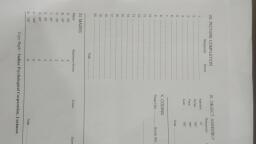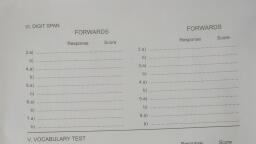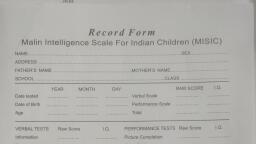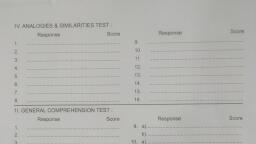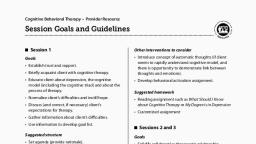Page 1 :
Malin’s Intelligence Scale for Indian Children (MISIC), Name of the Administrator: …………………………………., Name of the subject/ Testee: ………………………………………….., Age: ……………….., , Gender: ……………., , Education: ………., , Aim: To study the intelligence of the subject with the help of a MISIC., Introduction:, Malin’s Intelligence Scale for children (MISIC) is the Indian adaptation of WISC (1959). The, original Wechsler Intelligence Scale for Children is an individual test for children from the ages of 5, to 15.11. The Indian adaptation covers only ten years from 6 to 15.11. Administration time is, approximately 2 hours., , The scale comprises eleven sub-tests divided into verbal and performance groups as follows:, Verbal Tests –, 1. Information, 2. Comprehension, 3. Arithmetic, 4. Similarities, 5. Vocabulary, 6. Digit span, , The Performance Tests –, 7. Picture Completion, 8. Block Design, 9. Object Assembly, 10. Coding, 11. Mazes., , The Indian adaptation omits the picture arrangement of the performance scale as it proved to be culturally biased, both as to content as well to form., These sub tests may be administered in any order convenient for rapport. Only 10 tests - 5 from each group –are, required for complete for complete scoring. In case more or fewer tests are taken appropriate score pro-rating is, called for. For safe validity however not less than four sub tests of each group should be taken. The verbal group has, an alternate in Digit Span test in case of spoilage or when the regional vernacular test drops the vocabulary test in, the upper age levels. The alternate should not be taken just to improve a score., , Scoring method, Scoring was done as per the manual. After raw scores were obtained for each sub-test, they were, transformed into standardized IQ scores. Further Verbal IQ, Performance IQ, and Total IQ (full scale, IQ) were also computed., Material:The Malin’s intelligence Scale for Indian Children by Dr. Arthur J. Malin, Manual, pencil,, timer.
Page 2 :
Instruction:There are eleven sub test each have different instructions. (Directions and scoring). Also, having different time limit., 1. Information test:, There are 30 question in this test. Examiner need to read each question as stated and in the given, order. Discontinue after five consecutive failure. Each item is scored 1 or 0., “I will ask you some questions you give me the answers”., 2. General comprehension test:, , “I will ask you some question, you need to answer me, , according to question”., 3. Arithmetic test: “I will give you some tasks and you need to act as per my instructions, you, are not allowed to use any paper pencil.”, 4. Analogies and similarities:, a) Analogies test: “Listen carefully as I am going to read you a sentence which you must, finish.”, b) Similarities test: “I will say some words you need to carefully listen and tell me in what, way those words are similar.”, 5. Vocabulary test: “I want to see how many words you know. For this I will ask you some, words and you tell me what you know about that word. For example tell me now what is, CYCLE? , what does it mean? , explain a little more.”, 6. Digital span test:, a) Forward: “I am going to say some numbers. Listen carefully and when I am finished, repeat them after me.”, b) Backward: “Now I am going to say some more numbers but this time when I stop you, say them backwards.”, 7. Picture completion: “I will going to show you some pictures in which there is a part missing, look carefully at the card and tell me what important part is missing.”
Page 3 :
8. Block design: “you see these blocks have different colours and they can be put together in a, picture like this. Now I am going to show you a picture made of red blocks and I want you to, try to copy it as quickly as you can.”, 9. Object assembly “These pieces will make something when arranged together. Go ahead and, put them together.”, 10. Coding:, , , Design A: “look at these and see how each one has some mark inside. Now look at, these a samples and I want you to put in each figure the same mark that you find here, in the top row. Here is a star so put this mark inside.”, , , , Design B: “look these boxes or square. See how each has a number in the upper half, and a mark in the lower half each number has its own special mark now look at the, samples here is a 2 so put in this mark and try the others until I tell you to stop.”, , 11. Mazes: show the sample and demonstrate with a pencil. “Imagine someone trying to get out, of here. He cannot cross the lines and you cannot lift the pencil once you start.”, , Actual Conduct:The test material was kept ready than the instruction were given when the subject understand, the instructions the test was administered. After finishing the test the introspective report was taken, from the subject. After completion of the manual and on the bases of the score the interpretation was, done., Introspective report:- -----------------------------------------------------------------------------------------------------------------------------------------------------------------------------------------------------------------------------------------------------------------------------------------------------------------------------------------------------------------------------------------------------------------------------------------------Discussion:-, , Conclusion:-

